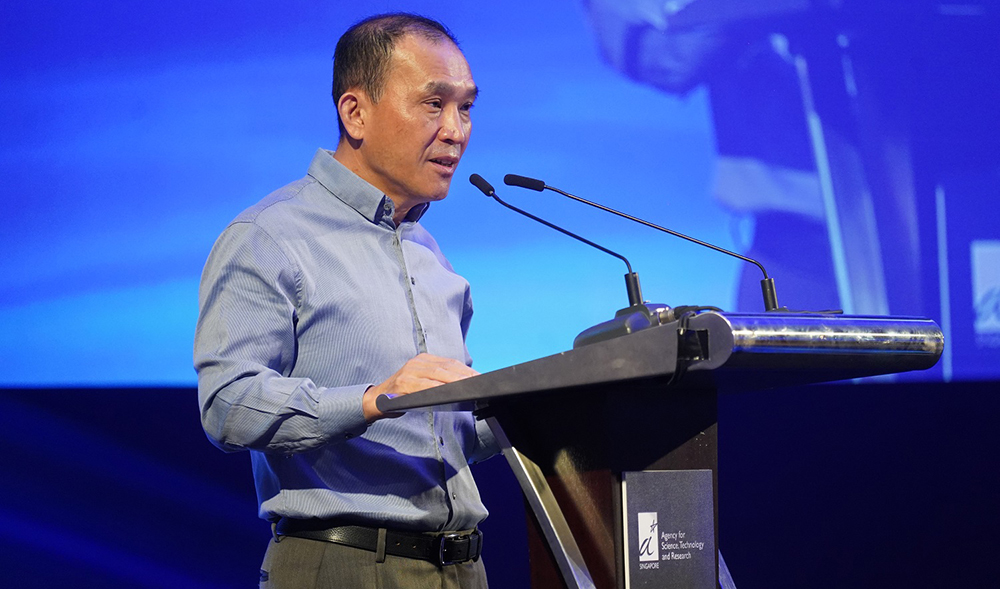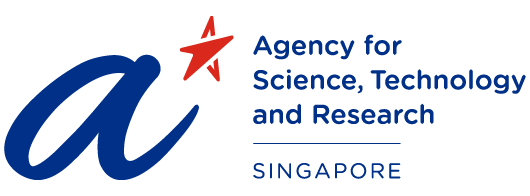A*STAR NEWS
Opening Address by Mr Lim Chuan Poh, Chairman of A*STAR, at the A*STAR Scientific Conference

Distinguished Speakers-
Friends and Colleagues-
Ladies and Gentlemen-
A very good morning to all of you.
WELCOME AND INTRODUCTION
It is with great pleasure that I welcome you to the 2018 A*STAR Scientific Conference.
Let me also welcome and thank all our speakers- some of whom have travelled some distance to be here with us today.
It was exactly a decade ago that we organised the inaugural A*STAR Scientific Conference. At that time- our objective was relatively modest – it was mainly to promote awareness of the overall spectrum of research conducted in A*STAR and encourage interactions between the researchers from BMRC with SERC. Even the scientific leadership did not know each other in those days. We have come a long way since.
This year’s conference theme is "Collisions: From Imagination to Impact"- which describes how different branches of knowledge can influence each other when they collide- so that what we imagine becomes innovation and delivers impact.
The programme today thus showcases a plethora of exciting discoveries and innovations in areas ranging from Artificial Intelligence (AI) to food- all of which have emerged from collisions of a wide variety of disciplines.
"Collisions": An Approach for overcoming today's complex challenges
The need for “collisions” arises primarily from the far more complex and challenging problems confronting the global community today and- therefore- the corresponding need to open up of the space for discoveries and innovations to find new solutions by bringing different disciplines to work together.
The last few decades of the twentieth century saw the rise of “multidisciplinary research”- where researchers from different disciplines work together- each drawing on his disciplinary knowledge.
Considerable progress had been made using this approach- but- some of the most complex of problems require closer integration of the disciplines- for example by sharing and combining methods- knowledge- and frameworks from across the different disciplines.
This “interdisciplinary” approach has given rise to new fields at the intersections of disciplines that transcend traditional disciplinary boundaries. For example- the field of bioinformatics integrates biology- statistics and computer science to make sense of vast amounts of biological and medical data- and the field of biomedical engineering tackles unmet medical needs by synthesizing the traditional engineering disciplines with medicine- as well as other disciplines such as materials science.
Such collisions of disciplines have led to great advancements and ground-breaking innovation in diverse areas ranging from synthetic chemistry to genomics.
This year’s Nobel Prize in Chemistry- for instance- was awarded to Frances Arnold- George Smith and Gregory Winter for their pioneering work on Directed Evolution – a new field that arose from the collision of evolutionary biology with synthetic chemistry.
Unlike traditional synthetic chemistry- in which reagents interact to form chemical products- Directed Evolution mimics evolution to create novel enzymes that are in turn used to catalyse new chemical reactions. [1]
Another illustration is the convergence of big data with genomics- which has enabled the development of next-generation sequencing technologies. This has led to numerous breakthroughs in the genomics field- including one here at A*STAR led by Dr Khor Chiea Chuen from GIS- in which the team analysed more than 11-000 patient samples using Deep Sequencing Analysis and discovered a novel mutation that protects against glaucoma. [2]
A further and very exciting area is that of AI- which will be explored in greater detail later in two of our keynote lectures and in the AI session. AI is positioned at the intersection between computer science- neuroscience and psychology- and the modern AI field arguably began to take shape in 1950- when Alan Turing proposed the concept of “machine learning”. [3]
In the decades that followed- the field flourished as computer scientists- neuroscientists and psychologists devised algorithms and neural networks that could enable computers to solve increasingly complex problems. But- it was only from the late 1990s that improvements in computational power finally caught up and allowed the conversion of many theoretical concepts into reality.
Today- the AI field is undergoing explosive growth and transforming virtually every research field and industry- from drug discovery – which you will hear more about from Professor Jackie Hunter– to autonomous vehicles and FinTech.
Here at A*STAR- we have an excellent research ecosystem populated by scientists and engineers from a wide range of disciplines. Our mission is to advance science and develop innovative technology to further economic growth and to improve lives.
A*STAR occupies the space between academia and industry and we will do what it takes to close the gap between academia and industry. The A*STAR transformation framework encourages and facilitates greater ease of such interdisciplinary collaboration. In RIE 2020 and looking ahead- we have seen and we expect more of such collaborations to be established to both tackle challenges and also enable us to seize new opportunities.
But- at A*STAR- we have and must continue to go beyond interdisciplinary research to establish public-private partnerships with industry under the Open Innovation Framework- to ensure that we close the loop from research to innovation and the enterprise. In a similar way- we should also close the gap between bench and bedside by partnering with the clinical community.
In RIE 2015 and RIE 2020 so far- we have also established many impactful partnerships with public sector agencies to harness A*STAR’s capabilities to realise PM’s vision of Singapore as a Smart Nation- as well as to contribute to solving some of our national challenges.
Harnessing the Power of Collisions
Our approach- therefore- is always to begin with the problem or mission in mind and to organise our capabilities around solving these problems or achieving the mission.
One recent example can be found in A*STAR’s Food and Consumer Cluster- which is organized around unmet needs of industry. Expertise from BTI and ICES were combined to develop a method for Nestlé to solubilise the sidestream of spent barley grain- potentially around 2-000 tonnes of spent grain per year at the factory level. Interestingly- the fermented sidestream could also be added back to the product- to create improved nutritional benefits.
For this reason- in RIE 2020- some of the funding initiatives have been redesigned to be more collaborative and larger in scale- with a heavier emphasis on the research problems to be targeted and the feasibility of the proposed approaches or solutions.
To bring the innovations closer to impact- biomedical research grants now typically have a translational component and require clinicians to be on board and most of the clinical translational grants are in fact led by clinicians. At the same time- significant portion of the funding has also gone into encouraging and facilitating public-private partnership with industry.
That said- we must never forget upstream investigator-led research- as it is an important source of transformative ideas and creations. This is why there are always Individual Research Grants available in each of the Domains.
Lastly- it is vitally important that we continue communicating and exchanging ideas with people from other fields and backgrounds- so that we can keep ourselves abreast of developments in other areas of research.
History has also shown that serendipity plays an important role in many discoveries- for instance in penicillin and X-rays. By keeping ourselves open to communication and scientific exchange- we increase the chance of encountering that crucial spark of inspiration. As the saying goes- luck favours the prepared mind.
Indeed- we have one such example at A*STAR’s Institute of Bioengineering and Nanotechnology. Dr Yang Yi Yan- who is also a speaker today at the Engineering Biology session- got her inspiration for a bacteria-killing polymer from a material developed for semiconductor applications- which she chanced upon at a conference in Australia. Her team’s polymer is promising as a possible solution to the global antibiotic resistance crisis- and was featured in Newsweek earlier this year. [4]
Conclusion
To conclude- by fostering collisions of disciplines and ideas- we can create infinite opportunities for serendipitous discoveries and gain inspiration for innovations that might otherwise not be available to us.
And when we add to that the power of imagination- we should be able to devise innovative and impactful solutions to the complex challenges faced by the world today- such as antibiotic resistance- food security- and climate change.
Today's conference is a great opportunity for disciplines to collide and influence each other- as we have participants from a wide variety of fields- from computer science to chemistry to medicine.
I hope everyone will go home at the end of the day with new ideas and inspiration for collaborations with others within and outside of A*STAR to greatly step up your discovery and innovation work.
On this note I would like to thank the organising committee- chaired by Professor Zee Upton- and her team for putting this event together.
Let me also thank all of you for your participation.
I wish everyone a fruitful and enjoyable scientific conference.
Thank you.
References
- Chang- K. (2018- October 3). "Use of Evolution to Design Molecules Nets Nobel Prize in Chemistry for 3 Scientists." The New York Times. Retrieved from: https://www.nytimes.com/2018/10/03/science/chemistry-nobel-prize.html
- Aung- T. et al. (2017). Genetic association study of exfoliation syndrome identifies a protective rare variant at LOXL1 and five new susceptibility loci. Nature Genetics- 49(7)- 993.
- Turing- A. M. (1950). Computing Machinery and Intelligence. Mind- 59(236)- 433.
- Georgiou- A. (2018- March 6). "Scientists Create Wonder Substance that can Kill Five Deadly Drug-Resistant Superbugs." Newsweek. Retrieved from: https://www.newsweek.com/scientists-create-wonder-substance-which-can-kill-5-deadly-drug-resistant-832959
Was This Article Helpful ?
A*STAR celebrates International Women's Day

From groundbreaking discoveries to cutting-edge research, our researchers are empowering the next generation of female science, technology, engineering and mathematics (STEM) leaders.
Get inspired by our #WomeninSTEM
